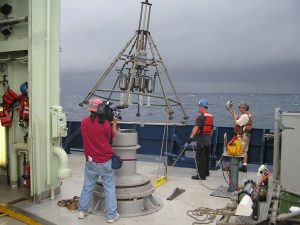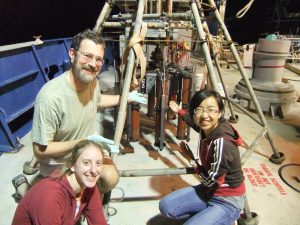Saving the World with Magic Bacteria
– December 10, 2012
The natural microbial community in the water column and on the sea floor of the northern Gulf of Mexico (GOM) surprised the watching world in the aftermath of the Deepwater Horizon Oil Spill (DHOS) by quickly working to help mitigate the effects of the oil. These “magic bacteria,” as some in the media dubbed them, played a pivotal role in processing the hydrocarbons released into the environment by the surge of oil. Jack Gilbert, Assistant Professor at the University of Chicago and researcher at the Argonne National Laboratory, is looking closely at these tiny organisms in the GoMRI RFP-II project, Creating a Predictive Model of Microbially Mediated Carbon Remediation in the Gulf of Mexico, and researching how these bacterial communities might operate in future spills of this magnitude.
Gilbert explains that the world these microbes inhabit is every bit as complex as our own, likening it to a city where everyone has a job to do to make society function seamlessly:
There are so-called ‘magic’ bacteria in there that eat the oil—that’s true. There are also bacteria that eat the waste that’s thrown out by the bacteria that eat the oil. There are bacteria that provide food for the others, and then bacteria that provide food to those bacteria, and so forth. We have to try to dismantle this complexity and make sense of it so we can predict these processes. Jack Gilbert, University of Chicago
Working with National Science Foundation funding in the immediate aftermath of the DHOS, Andreas Teske of the University of North Carolina at Chapel Hill was in the area within a week of the explosion and continued the taking samples for months. Gilbert and Teske, coordinating with the Department of Energy’s Joint Genome Institute, then extracted the DNA and other genetic material from the bacteria samples in an effort to catalog the various species and understand the “job” of each in the complex society beneath the waves.
With the majority of the genetic sequencing completed, the pair, in collaboration with Nicole Scott at University of Chicago, will now begin inputting data into a model to predict the behavior of these bacteria under specific conditions. Gilbert goes back to the metaphor of the city to explain the goal. Just as a drastic changes in weather might change peoples’ jobs in a city—a huge reduction in snowfall in Chicago, for example, might put anyone who works clearing roads out of work—changes in conditions in the GOM might alter the way the bacteria are able to process oil. Gilbert, Scott and Teske’s model will ascertain how temperature changes and other factors could impact these natural processes as they currently operate so that if another oil spill occurs, scientists will be able to correctly estimate the amount of mitigation the bacteria will perform under their current climate conditions and plan accordingly.
It’s important for our regulators, for our government, for the people who are affected by these oil spills to actually be able to predict how that would happen. If we can use these models and act on these predictions, then they can save billions if not trillions of dollars and completely change the impact of those events upon the public, upon government, and upon private enterprise. Jack Gilbert, University of Chicago
The modeling infrastructure has been designed, now the model needs to be trained to include new data. Once this process is complete, Gilbert, Scott and Teske can populate the models with new environmental conditions that will play into the predictive process and make it as accurate as possible.
Gilbert makes a point that the community that is studying the oil spill—scientists, investigators, policy makers, industrial professionals, and environmentalists—are every bit as complex in their relationships with one another as the environmental system they are all studying. It’s in everyone’s best interest to have a plan in place for future because everyone is negatively impacted when things go badly, so these various professionals work together and provide data that he can use in his model.
Gilbert says laughingly, “That’s what we do—we’re saving the world.” He then adds, “And it’s not just the magic bacteria we’re looking at to do it; it’s all of them. They’re all magic.”
This research is made possible by a grant from The Gulf of Mexico Research Initiative (GoMRI). The GoMRI is a 10-year, $500 million independent research program established by an agreement between BP and the Gulf of Mexico Alliance (GOMA) to study the effects of the Deepwater Horizon incident and the potential associated impact of this and similar incidents on the environment and public health.
© Copyright 2010- 2017 Gulf of Mexico Research Initiative (GoMRI) – All Rights Reserved. Redistribution is encouraged with acknowledgement to the Gulf of Mexico Research Initiative (GoMRI). Please credit images and/or videos as done in each article. Questions? Contact web-content editor Nilde “Maggie” Dannreuther, Northern Gulf Institute, Mississippi State University (maggied@ngi.msstate.edu).







